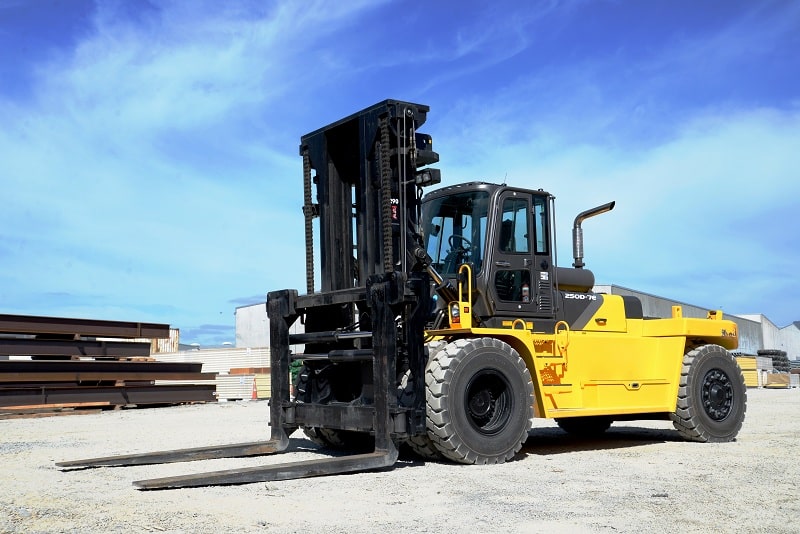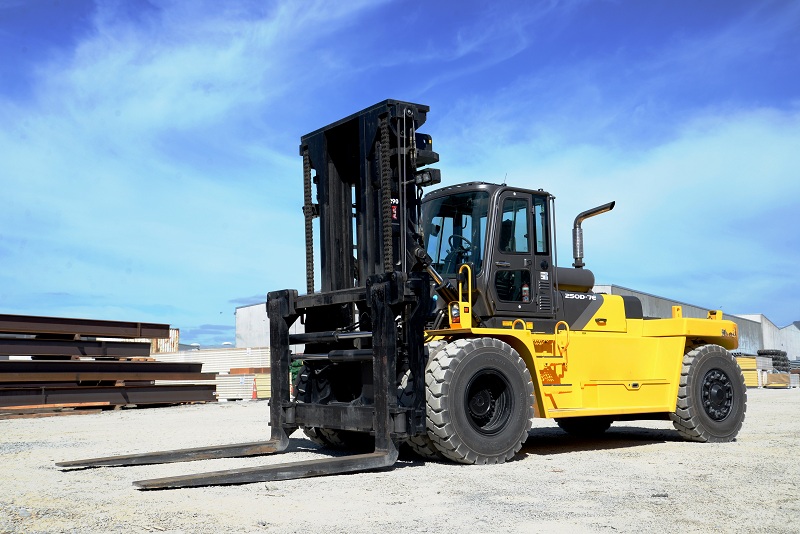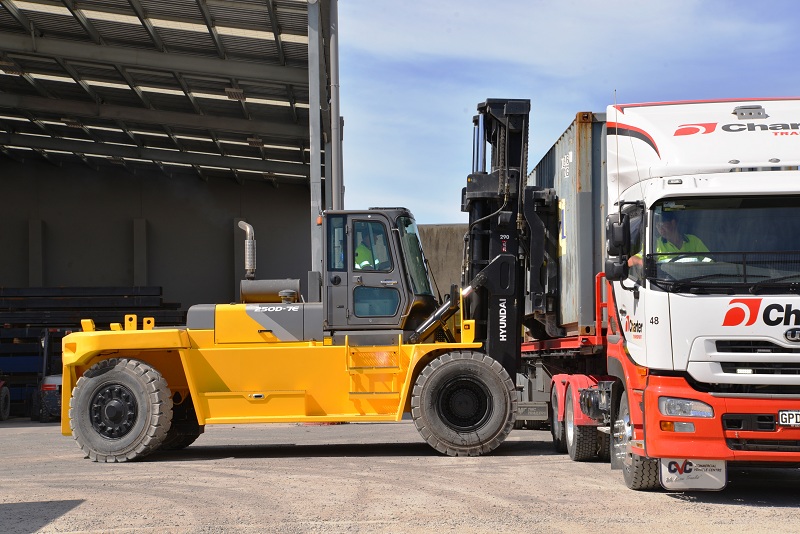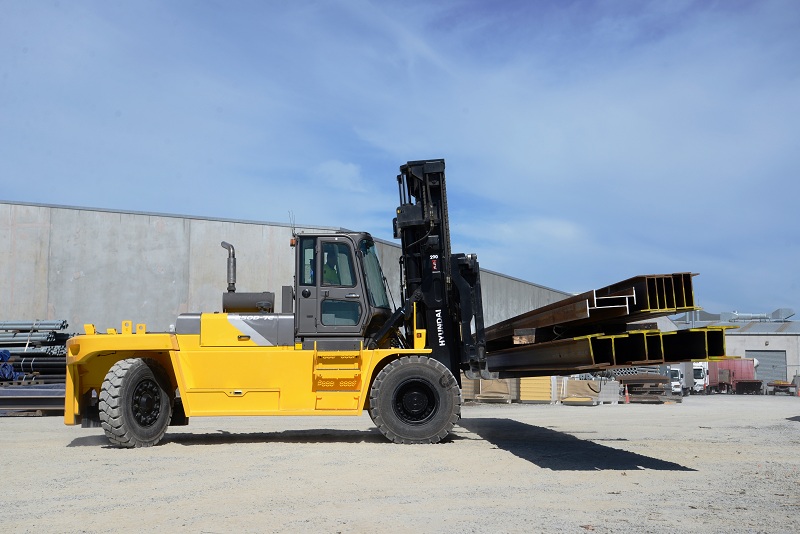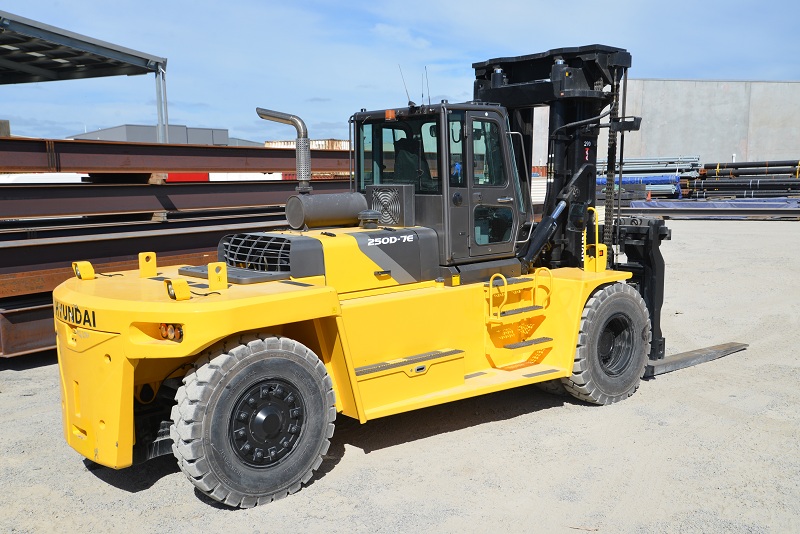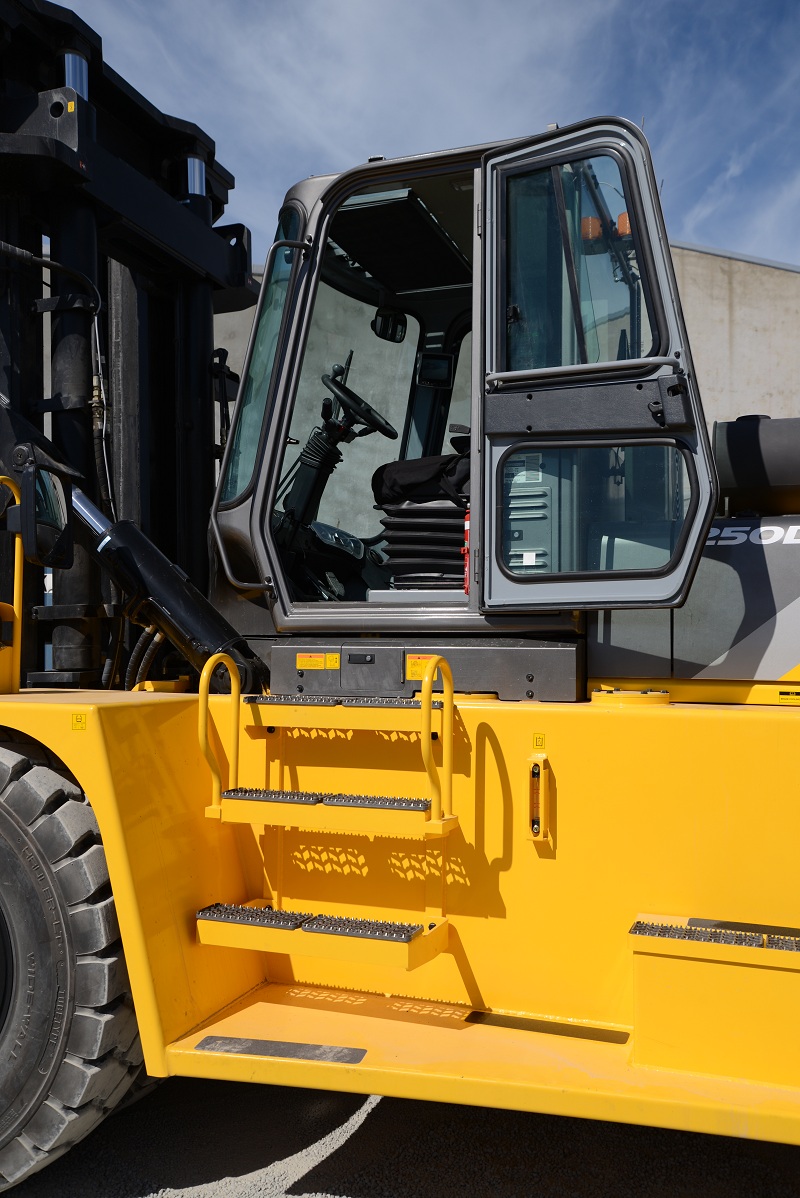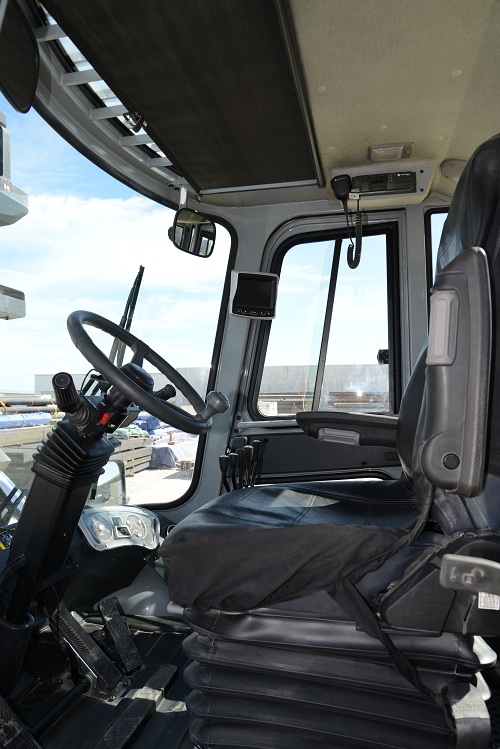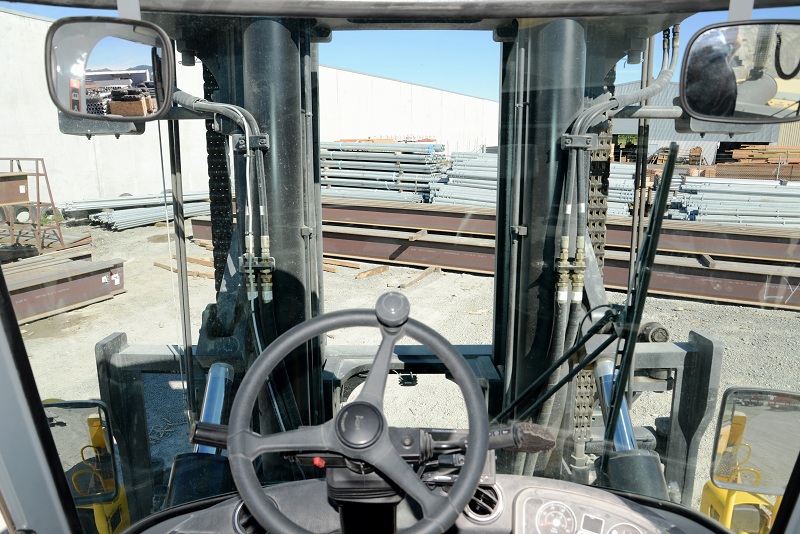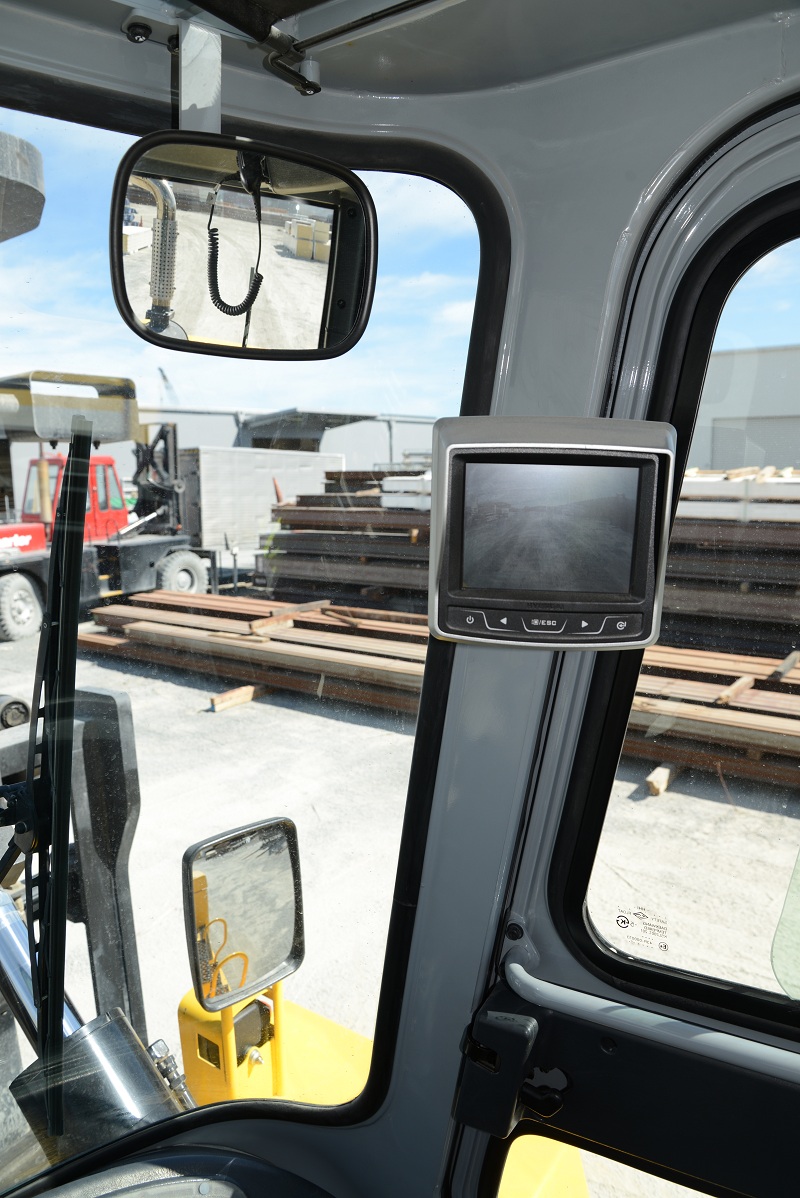The largest industrial Hyundai fork hoist is the 250D-7E.
The Hyundai 250D-7E is the new flagship Hyundai Series 7 Industrial Forkhoist. This heavy duty South Korean sourced machine has a lifting capacity of 25,000 kg and has an unloaded top speed of 31.7 kph. Overall length including the 2450mm fork tines is 8812mm, and it has a 4250mm wheelbase with a turning radius of 5807mm. It has a tare weight of approximately 37,000 kgs and runs a Kessler drive axle with oil cooled disc brakes. The test machine was fitted with a two stage mast and had a lifting height of 4030mm
HYUNDAI 250D-7E FORKHOIST
Power comes from a 6 cylinder turbocharged Cummins QSC Engine rated at 194 KW (263 hp) governed at 2200 rpm. It features an exhaust gas recirculation (EGR) subsystem mated to Cummins’ own compact catalyst system to achieve Tier 3 and EU stage IIIA low emission standards. There are two engine control modes in which ‘Standard Mode’ can be selected for fuel reduction and light duty operating or ‘Power Mode’ for heavy duty work, or operating loaded on slopes or gradients. The engine is easily accessible for maintenance checks and servicing with large lockable hinged opening hoods on both sides, and the cab itself can be hydraulically tilted sideways for clear and easy access to the hydraulics. It runs a 24 volt electrical system. The transmission is a German made ZF Model 3WG21 electronically controlled fully automatic gearbox which has 3 speeds forward and reverse. It can also be lever operated manually.
HYUNDAI 250D-7E FORKHOIST CAN AND CONTROLS
The ergonomics of the almost air-tight cab are good, with well-placed gauges and controls. There is a console to the right of the operator which houses all of the controls and switches (other than those mounted on the steering column). This console is at the optimum height and these controls and switches require no stretching or movement out of a comfortable seating position to utilise.
The steering wheel has a 40 degree lateral adjustment along with 80mm of telescopic adjustment and this along with the adjustable suspension seat will ensure a comfortable seating position for all shapes and sizes of operator.
The Hyundai 250D-7E cab is spacious and standard equipment includes, load sensor/onboard weighing, steer wheels positioning display, auto park brake, cruise control, air-conditioning and heating, rear view camera, MP3 CD player/USB, headphone ports and a Hi Mate Remote Management System. Storage space is limited to a couple of document holders, a small open tray and a drink/cup holder.
HYUNDAI 250D-7E FORKHOIST: THE DRIVE
Access to the cab is very good, with well-appointed steps and grab handles. With there being numerous seat and steering wheel adjustments, it was not difficult to find a comfortable driving position before moving off. We were fortunate enough to test the 250D-7E in its everyday working conditions, including the moving of 20 tonne plus lifts of structural steel from 12 to 18 metres in length, and also loading/unloading 20’ shipping containers on and off semi-truck and trailer units. Some of the shipping containers weighed up to the machine’s basic maximum lifting capacity of 25,000kgs, which was ideal for this test. The controls were responsive and accurate as was the acceleration and disc braking.
The 2450mm fork tines are compatible for lifting shipping containers and there is a 12 degree forward tilt and a 10 degree backward tilt with ample side shift which was helpful when centring loads and loading onto container twistlocks (the fork tines can also be moved independently). The gearbox can be operated in manual or full automatic and the changes are smooth and precise in both modes. We operated the Engine Control mode in ‘Standard’ mode for most of the drive, however when we did test the ‘Power’ mode, noticing a slight difference, albeit not significant enough to warrant having it selected on this mode for the duration in these test conditions.
The heavy duty Hyundai 250D-7E handled well and felt stable at all times, even when in transit, and when cornering with 25,000kg shipping containers (including stacking them two high). The same stability and handling was apparent when moving 18 metre long structural steel, which is impressive considering there was more than 7 metres of overhang to each side of the fork tines.
Manoeuvrability in tight area’s was good for a machine of this size especially considering the fact we were operating a 25,000kg capable fork hoist in at times very confined spaces. In saying this it felt very agile so that the machine did not actually have a heavy duty feel about it during these manoeuvres.
Vision from the driver’s seat was exceptionally good with plenty of glass including a roof mounted window with a functional blind to block the sun when not required. Forward views are obstructed only by the mast itself and this test unit had been retro fitted with a mast mounted camera and separate in cab monitor, which helped negate the forward facing blind spots when lining up a lift. There are four rear vision mirrors (two internally mounted in the cab and two externally on either side) and also a factory fitted rear view camera with another in-cab monitor. The only downside with this well placed rear view camera monitor is that the same screen is used for the digital load sensor read out and steer wheels positioning display, meaning a button is required to be pushed to select either function. A function that switched the screen to rear camera view automatically when reverse was selected would negate this minor annoyance.
On the day of this test there was a typical hot Canterbury Plains ‘Norwester’ blowing with outside temperatures of more than 25 degrees Celsius. What a perfect day to test the air conditioning we thought, and whilst switching on the aircon we noticed that on top of the windscreen demister vents, there were no less than 8 other air vents (four forward of the driver and four behind the driver seat). Needless to say the cool air circulated the cab in no time and was very effective.
There were also no less than 6 forward facing LED lights (including 2 on each side of the mast) and two rear facing (not including the standard brake/indicator/reversing lights) for night time operation.
HYUNDAI HI MATE REMOTE MANAGEMENT SYSTEM
Another feature of the 250D-7E that is well worth mentioning is the GPS based Hi Mate Remote Management system. This is a live online reporting system allowing the management and service agent, up-to-the-minute access on all facets of the forklift operation. This monitors a multitude of things, among them are full maintenance reports, idling/working time reports, fuel usage, hour and kilometre readings (daily, weekly and overall totals). It can also calculate the total weight the machine lifts per day and populates it into graphs showing totals and averages.
This feature is a genuine tool to measure the performance of the machine and of course the service sgent can monitor and schedule servicing remotely.
SUMMARY
The ease of operation, versatility and almost nimble characteristics of this machine almost belie its size and lifting capacity. This is a sizable machine, yet (first impressions at least) we found ourselves having to remind ourselves of this. It was quiet, comfortable, had good vision and ample power lifting and also in transit. It was ideally suited to the operation in which it was tested and was a true 25,000 kg capacity unit – in fact it lifted these weights with ease.
Oddly the only concern we had was the ease of operation compared to the size and lifting capability of the machine. This is actually a testament to the designers, however we believe an inexperienced operator could get into trouble pretty quickly if not managed properly, as there are serious weights being lifted. This is however, a training issue and hardly a fault of the machine itself.
Is the fact that there is currently only one of these machines in the country a potential problem for parts? The obvious answer of course would be yes, however in this instance when we look at the running gear, Cummins and ZF, we note that these parts are readily available here and are specced in other makes and models of heavy machinery in New Zealand. The hydraulics are not an issue and the cab itself is generic and used on smaller models so we do not foresee any major problems in this area.
Hot or cold conditions, day or night, we believe the 250D-7E is certainly a contender in this fork hoist weight class.
HYUNDAI 250D-7E FORKHOIST SPECS
Basic capacity 25,000 kgs
Load centre 1200 mm
Lift height 4030 mm
Lowered height 3877 mm
Mast rating capacity 25,000 kg
Load centres 1200 mm
Tilt forward 12.0° tilt
Tilt backward 10.0° tilt
Forks length 2450mm
Engine make Cummins
Model QSC
Fuel Diesel
Rated output 194kW
Governed speed 2200 rpm
Displacement 8300 cc
Electrical system 24 Volts
Emission EPA Tier III & CARB(California Air Resources Board) compliant
Transmission Type ZF Electronic Fully Automatic Model 3WG21
Speeds 3 speeds, forward/reversE
Drive axle Kessler axle with Wet Disc Brakes
Chassis width 3050 mm
Overall length 6362 mm to face of forks
Photography: Dean Middleton


